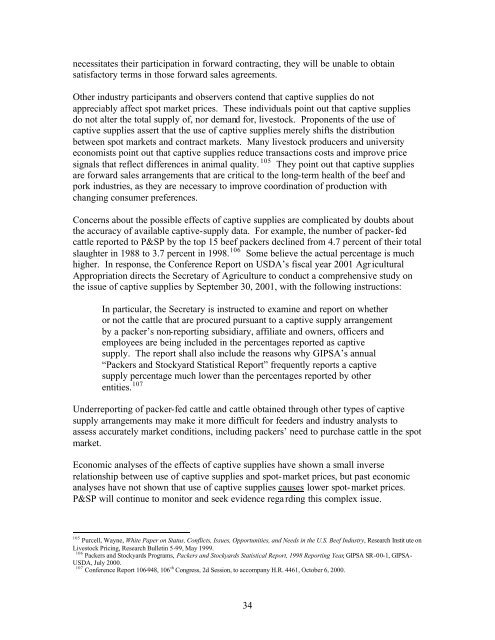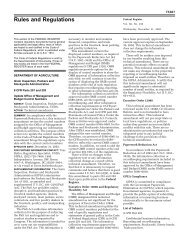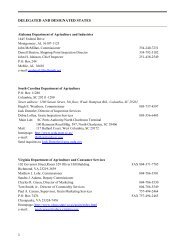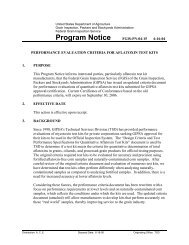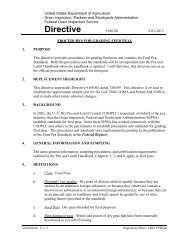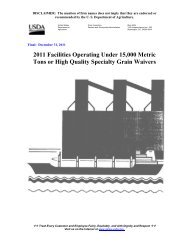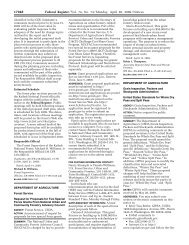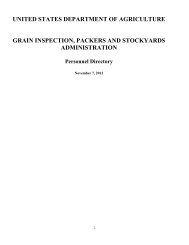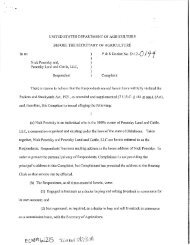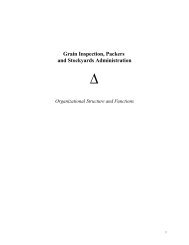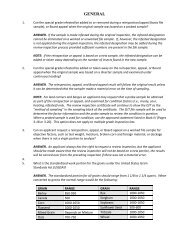Assessment of the Cattle and Hog Industries Calendar Year 2000
Assessment of the Cattle and Hog Industries Calendar Year 2000
Assessment of the Cattle and Hog Industries Calendar Year 2000
You also want an ePaper? Increase the reach of your titles
YUMPU automatically turns print PDFs into web optimized ePapers that Google loves.
necessitates <strong>the</strong>ir participation in forward contracting, <strong>the</strong>y will be unable to obtain<br />
satisfactory terms in those forward sales agreements.<br />
O<strong>the</strong>r industry participants <strong>and</strong> observers contend that captive supplies do not<br />
appreciably affect spot market prices. These individuals point out that captive supplies<br />
do not alter <strong>the</strong> total supply <strong>of</strong>, nor dem<strong>and</strong> for, livestock. Proponents <strong>of</strong> <strong>the</strong> use <strong>of</strong><br />
captive supplies assert that <strong>the</strong> use <strong>of</strong> captive supplies merely shifts <strong>the</strong> distribution<br />
between spot markets <strong>and</strong> contract markets. Many livestock producers <strong>and</strong> university<br />
economists point out that captive supplies reduce transactions costs <strong>and</strong> improve price<br />
signals that reflect differences in animal quality. 105 They point out that captive supplies<br />
are forward sales arrangements that are critical to <strong>the</strong> long-term health <strong>of</strong> <strong>the</strong> beef <strong>and</strong><br />
pork industries, as <strong>the</strong>y are necessary to improve coordination <strong>of</strong> production with<br />
changing consumer preferences.<br />
Concerns about <strong>the</strong> possible effects <strong>of</strong> captive supplies are complicated by doubts about<br />
<strong>the</strong> accuracy <strong>of</strong> available captive-supply data. For example, <strong>the</strong> number <strong>of</strong> packer-fed<br />
cattle reported to P&SP by <strong>the</strong> top 15 beef packers declined from 4.7 percent <strong>of</strong> <strong>the</strong>ir total<br />
slaughter in 1988 to 3.7 percent in 1998. 106 Some believe <strong>the</strong> actual percentage is much<br />
higher. In response, <strong>the</strong> Conference Report on USDA’s fiscal year 2001 Agricultural<br />
Appropriation directs <strong>the</strong> Secretary <strong>of</strong> Agriculture to conduct a comprehensive study on<br />
<strong>the</strong> issue <strong>of</strong> captive supplies by September 30, 2001, with <strong>the</strong> following instructions:<br />
In particular, <strong>the</strong> Secretary is instructed to examine <strong>and</strong> report on whe<strong>the</strong>r<br />
or not <strong>the</strong> cattle that are procured pursuant to a captive supply arrangement<br />
by a packer’s non-reporting subsidiary, affiliate <strong>and</strong> owners, <strong>of</strong>ficers <strong>and</strong><br />
employees are being included in <strong>the</strong> percentages reported as captive<br />
supply. The report shall also include <strong>the</strong> reasons why GIPSA’s annual<br />
“Packers <strong>and</strong> Stockyard Statistical Report” frequently reports a captive<br />
supply percentage much lower than <strong>the</strong> percentages reported by o<strong>the</strong>r<br />
entities. 107<br />
Underreporting <strong>of</strong> packer-fed cattle <strong>and</strong> cattle obtained through o<strong>the</strong>r types <strong>of</strong> captive<br />
supply arrangements may make it more difficult for feeders <strong>and</strong> industry analysts to<br />
assess accurately market conditions, including packers’ need to purchase cattle in <strong>the</strong> spot<br />
market.<br />
Economic analyses <strong>of</strong> <strong>the</strong> effects <strong>of</strong> captive supplies have shown a small inverse<br />
relationship between use <strong>of</strong> captive supplies <strong>and</strong> spot-market prices, but past economic<br />
analyses have not shown that use <strong>of</strong> captive supplies causes lower spot-market prices.<br />
P&SP will continue to monitor <strong>and</strong> seek evidence regarding this complex issue.<br />
105 Purcell, Wayne, White Paper on Status, Conflicts, Issues, Opportunities, <strong>and</strong> Needs in <strong>the</strong> U.S. Beef Industry, Research Instit ute on<br />
Livestock Pricing, Research Bulletin 5-99, May 1999.<br />
106 Packers <strong>and</strong> Stockyards Programs, Packers <strong>and</strong> Stockyards Statistical Report, 1998 Reporting <strong>Year</strong>, GIPSA SR-00-1, GIPSA-<br />
USDA, July <strong>2000</strong>.<br />
107 Conference Report 106-948, 106 th Congress, 2d Session, to accompany H.R. 4461, October 6, <strong>2000</strong>.<br />
34


